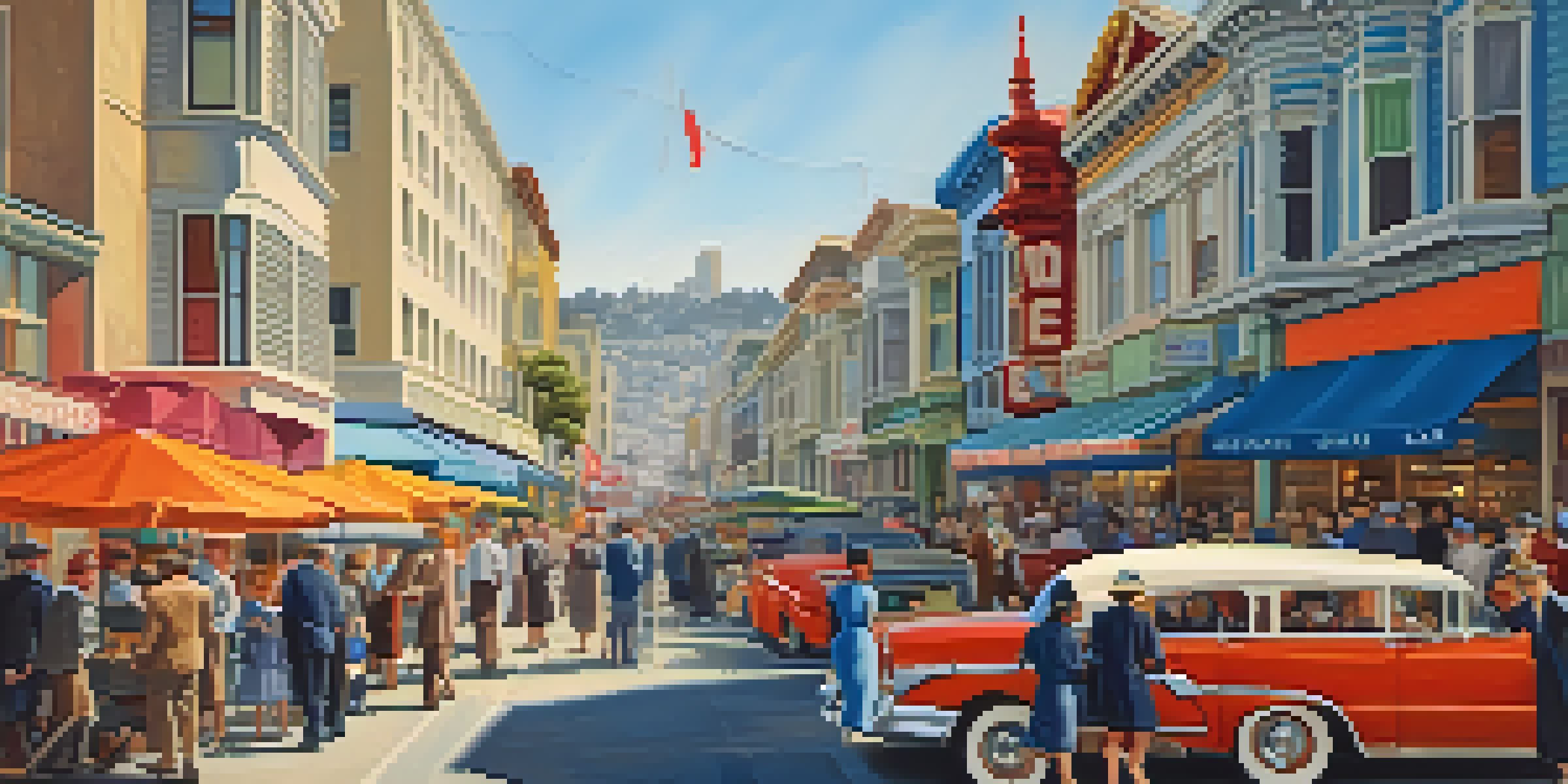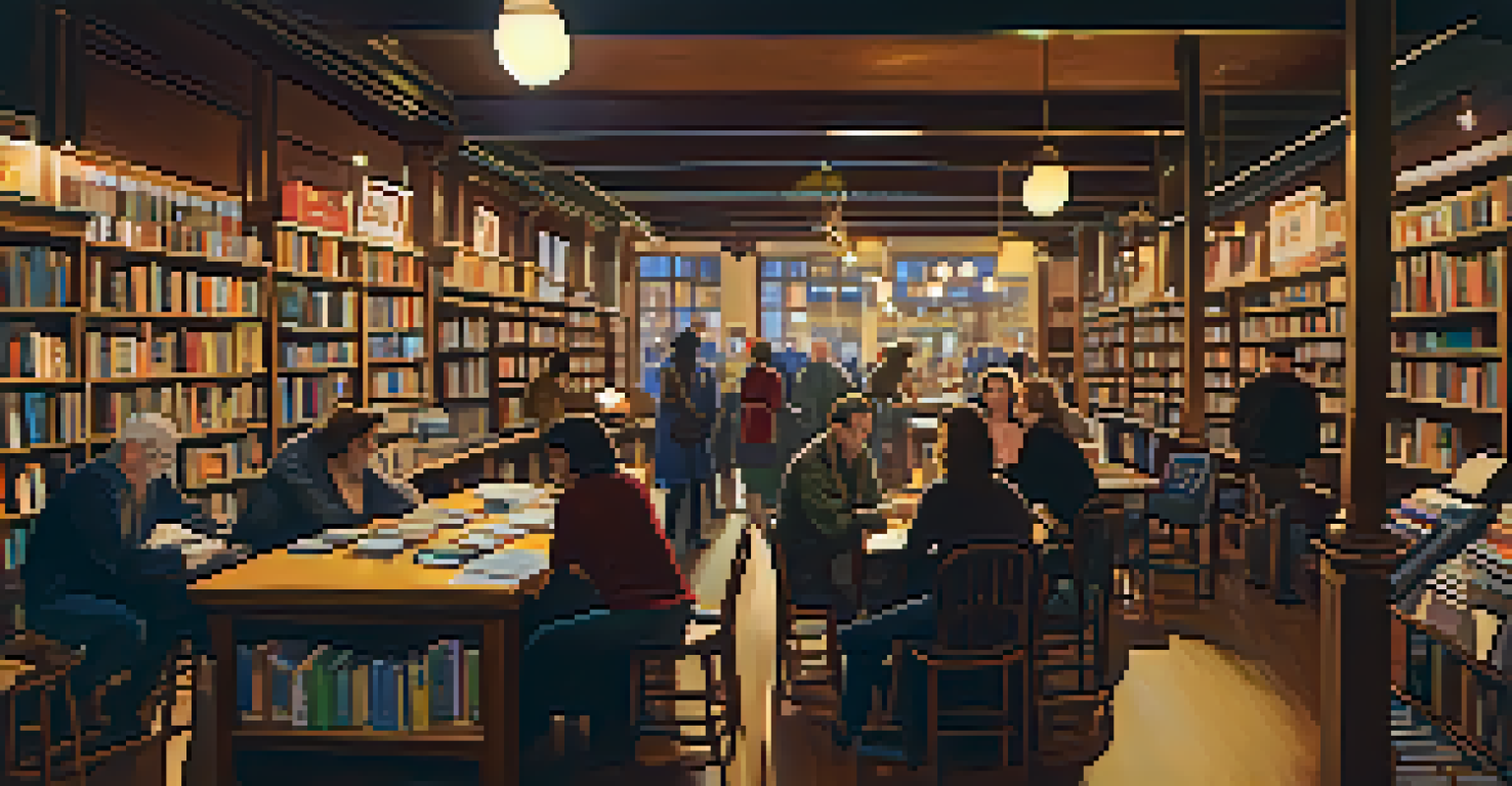The Beat Generation: San Francisco's Literary Revolution

What Was the Beat Generation? A Brief Overview
The Beat Generation emerged in the 1950s as a literary and cultural movement that challenged the norms of American society. Centered around writers like Jack Kerouac, Allen Ginsberg, and William S. Burroughs, it embraced a lifestyle that celebrated spontaneity and rebellion. The term 'Beat' reflects not only a sense of weariness but also a rhythm of life that was both frenetic and deeply soulful.
The best teacher is experience and not through someone's distorted point of view.
These writers sought to break free from traditional literary constraints, exploring themes of spirituality, sexuality, and existentialism. Their works often drew inspiration from jazz music, Eastern religions, and a disdain for materialism. The result was a raw, unfiltered style that resonated with a generation looking for authenticity in a rapidly changing world.
In many ways, the Beat Generation laid the groundwork for the counterculture movements that would follow. Their influence extended beyond literature, impacting art, music, and social attitudes. As they congregated in cities like San Francisco, a cultural revolution began to take shape, one that would redefine American identity.
San Francisco: The Heart of Beat Culture
San Francisco became the epicenter for the Beat Generation, attracting artists and writers from across the nation. The city's vibrant atmosphere, characterized by its bohemian neighborhoods like North Beach, provided fertile ground for creativity. Cafés like the City Lights Bookstore became essential meeting points where ideas flourished and friendships formed.

The unique spirit of San Francisco helped to amplify the messages of the Beats, allowing them to reach a wider audience. Here, they found a community that embraced their unconventional lifestyles, fostering an environment where self-expression was celebrated. This sense of belonging was crucial for many writers who felt out of place elsewhere.
Beat Generation's Cultural Impact
The Beat Generation challenged societal norms and laid the groundwork for future counterculture movements, influencing art, music, and social attitudes.
Moreover, the city's rich cultural tapestry, infused with diversity and progressive values, resonated with the Beats' ideals. Their writings often reflected the struggles and joys of life in San Francisco, offering a raw glimpse into the social fabric of the time. This connection between the city and the Beat Generation remains a defining aspect of their legacy.
Key Figures of the Beat Generation
Among the most prominent figures of the Beat Generation was Jack Kerouac, whose novel 'On the Road' became a defining work of the movement. His spontaneous prose style mirrored the jazz rhythms that influenced his writing, inviting readers on a journey of self-discovery and adventure. Kerouac's exploration of American landscapes and cultures resonated with many, making him a literary icon.
I am in the midst of a great career, and I am not afraid of the future.
Allen Ginsberg, another pivotal figure, challenged societal norms with his poetry, most notably in 'Howl.' His candid exploration of sexuality, mental health, and spirituality pushed boundaries and sparked conversations that still resonate today. Ginsberg's work not only solidified his place within the Beat movement but also influenced generations of poets and activists.
William S. Burroughs, known for his unconventional narrative style, introduced readers to the darker sides of society in works like 'Naked Lunch.' His experimental approach to storytelling blurred the lines between fiction and reality, inviting readers to confront uncomfortable truths. Together, these writers formed a trio that would define the essence of the Beat Generation.
Literary Style and Techniques of the Beats
The literary style of the Beat Generation was characterized by spontaneity, free verse, and a rejection of traditional narrative structures. This approach allowed writers to capture the immediacy of their experiences and convey raw emotions. For instance, Kerouac's use of 'stream of consciousness' writing created a sense of urgency that drew readers into the moment.
Jazz music played a significant role in shaping the Beats' literary techniques, influencing their rhythms and cadences. The improvisational nature of jazz inspired many writers to adopt a similar approach in their work, resulting in prose that felt alive and dynamic. This connection between music and literature created a unique synergy that set the Beat Generation apart.
Key Figures Shaped Beat Literature
Writers like Jack Kerouac, Allen Ginsberg, and William S. Burroughs defined the Beat Generation through their innovative works that explored themes of individuality and rebellion.
Additionally, the Beats often incorporated elements of Eastern philosophy into their writing, exploring themes of transcendence and enlightenment. This fusion of styles and ideas contributed to a rich tapestry of literature that challenged conventional norms. The result was a body of work that not only entertained but also provoked thought and discussion.
The Beats and the Counterculture Movement
The Beat Generation laid the groundwork for the counterculture movements of the 1960s, influencing everything from art to politics. Their emphasis on individuality and self-expression resonated with young people seeking alternatives to mainstream values. The Beats’ rejection of materialism and embrace of spiritual exploration inspired a generation to question societal norms.
As the counterculture movement gained momentum, elements of Beat philosophy became intertwined with the growing anti-war and civil rights movements. The Beats’ advocacy for freedom of expression and social justice found a home among activists who sought to challenge the status quo. This interconnectedness amplified the impact of both movements, leading to a cultural renaissance.
Moreover, the legacy of the Beat Generation can be seen in the works of later writers, musicians, and artists who drew inspiration from their ideas. The rebellious spirit and desire for authenticity that defined the Beats continue to resonate in contemporary culture, reminding us of the power of creative expression.
Key Works that Shaped Beat Literature
'On the Road' by Jack Kerouac stands out as one of the cornerstone texts of the Beat Generation. Its exploration of freedom, friendship, and the search for meaning resonates with readers even today. The novel's road trip narrative serves as a metaphor for the quest for identity and belonging, capturing the essence of the Beat experience.
Another significant work is Allen Ginsberg's 'Howl,' which challenged the conventions of poetry with its raw honesty and social critique. The poem's vivid imagery and powerful language addressed issues of mental health, sexuality, and societal repression, making it a landmark piece of American literature. Ginsberg's fearless approach paved the way for future poets to express their truths.
Enduring Legacy of the Beats
The legacy of the Beat Generation lives on in contemporary culture, inspiring new voices and creative expressions that challenge traditional norms.
William S. Burroughs' 'Naked Lunch' pushed the boundaries of narrative structure and content, offering a fragmented, nonlinear exploration of addiction and society. Its controversial themes and experimental style sparked debates about censorship and artistic freedom. Together, these works not only defined the Beat Generation but also left an indelible mark on American literature.
The Enduring Legacy of the Beat Generation
The impact of the Beat Generation extends far beyond its time, influencing countless writers, artists, and cultural movements. Their emphasis on authenticity and self-expression continues to resonate with those seeking to challenge societal norms. The Beats' fearless exploration of taboo subjects opened doors for future generations to engage in conversations about identity, sexuality, and spirituality.
Moreover, their contributions to literature have paved the way for diverse voices to emerge in contemporary writing. The Beats' rejection of traditional forms has inspired a wave of experimental literature that embraces unconventional narratives and styles. This legacy of innovation is evident in the works of many modern authors who draw from the Beat ethos.

In popular culture, the spirit of the Beat Generation lives on through music, film, and art. Many contemporary artists cite the Beats as influences, reflecting their enduring relevance. As we continue to navigate the complexities of modern life, the lessons and inspirations of the Beat Generation remain a vital part of our cultural landscape.